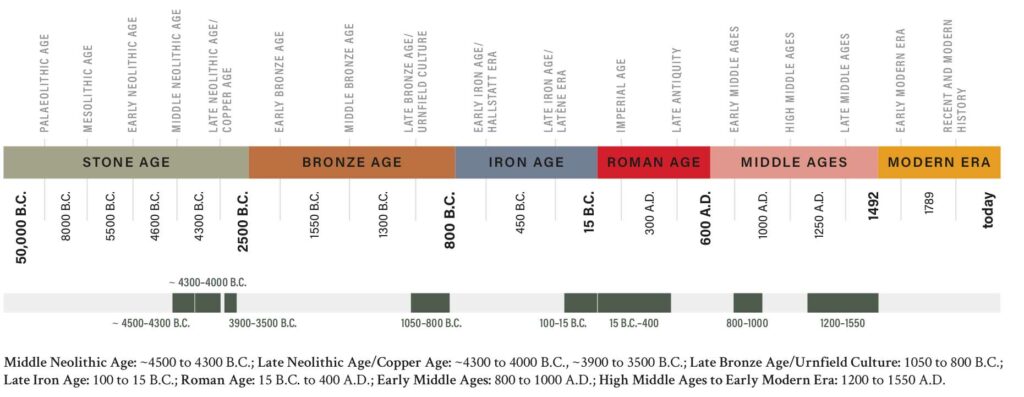As is so often the case in archaeology, the beginning of archaeological excavations and the discovery of the first walls of the castle happened by chance during construction works. In 2004 it was decided to build a new elevated water tank on the slightly elevated plateau to the east of the castle for the regional nursing home, which was still located in Schwanberg Castle at that time. When the excavation work started, mighty stone walls were encountered shortly afterwards, which quickly proved to be part of the old castle site. In the same year, a short but decisive archaeological emergency excavation was carried out. This first emergency excavation, which lasted only a few days, brought to light the defensive walls of a round tower, which were up to four meters thick. In the following years, the archaeologists painstakingly made numerous sections with shovel and trowel. In the process, tons of earth were removed by hand from year to year, and it became increasingly clear that not only was there originally a medieval castle here, but also that the history of Schwanberg can be traced back much further into the past than previously assumed. In the meantime, research excavations are being carried out on behalf of the municipality and the “Komitee Altburg Schwanberg” (Schwanberg Old Castle Committee), the aim of which is to investigate the development of the castle and its predecessor structures in greater detail.
Those buildings, which are still partially visible to visitors today, essentially date back to the late Middle Ages. In the northwest, halfway up the plateau, there is a massive and imposing round tower. This so-called shell tower or half tower and the adjoining massive fortification wall probably date from the second half of the 15th century, as examples from other castles prove. The walls and the tower seem to have been built at the same time, using the local gneiss. Since the tower is no longer preserved in its full height, structural elements such as embrasures can only be assumed. This building is evidence of the last construction phase of a fortified building, which was probably rebuilt and enlarged again and again over several centuries in one and the same place.
The rectangular ring wall, which once enclosed the actual plateau, could be traced in several places in the foundation area as well as in the rising masonry. The walls visible today are a reconstruction of this complex, which was probably built towards the end of the High Middle Ages and at the beginning of the Late Middle Ages. Large areas of the plateau were filled in for the construction, others were probably leveled, which largely destroyed the existing remains of earlier construction phases. The massive wall has a width of about 1.5 m at all points and has a slightly warped but approximately rectangular shape towards the east – only the north and south walls seem to have been slightly slanted towards the east in order to adapt to the natural features of the terrain. Inside, the wall covered an area of slightly more than 1,150 square meters. The entrance to the castle was most probably in the east, just next to the area where a newly built path leads up to today’s entrance.
Several buildings were attached to the fortification wall inside. In the southeast corner there was a larger building, which may be addressed as the (residential) tower of the castle. Also along the eastern wall, adjacent to the first building, was another building, the outer wall of which had a thickness of slightly more than one meter. The building had a length of about 17 m and a width of about 9 m. Here, too, only parts of the foundation have so far been uncovered. Again, with great caution, this building can be interpreted as a palace. A third building was located in the northwest corner of the ring wall. There, foundations were uncovered which had a width of about 2.1 m, built only with rubble stones and without mortar. The two 8.5 m long wall foundations were attached to the ring wall, resulting in an approximately square ground plan. It is possible this was a wooden tower with stone foundations. This is also indicated by the large number of iron nails discovered during the excavation of the foundation.
Other important elements of a medieval castle were wells and cisterns. In the case of the Schwanberg complex, both could be excavated archaeologically. In the northern area of the courtyard there was a small well with a diameter of about one meter. In addition, the remains of a cistern were discovered in the southwest corner of the area. The circular structure, which was largely under the surface, was lined with clay on the inside. It had a diameter of 5.8 m at its widest point, but narrowed towards the top, where there must have been a well-like extraction point.
Besides the archaeological remains, there are several literary sources that can be used for the reconstruction of the castle. For example, it turned out only in the course of the excavations that archival documents in the Austrian State Archives from the year 1525 can be referred to the finding-place. These are letters from the Lower Austrian Court Chamber to Ferdinand I, Archduke of Austria, into whose ownership the castle had come. Previously, the Spangsteins, who inhabited the castle, had complained about damage to walls and buildings. A commission sent thereupon (the governor representing the sovereign, Wolfgang Graswein, as well as two master builders, Marquart Zehentperger and Hans Hofenawer) advocated the demolition of the dilapidated tower; a ring wall and two half towers existed, an escape place could possibly be created for the population, but this would be connected with considerable costs. The structure described as “alt purgkhstall, daran ein anfang aines paus zwayer turm …” is with certainty the castle on the “Tanzboden” now under investigation. An outer castle, or at least a single tower, has been located on the foothills of the Josefiberg hill, 200 m to the northeast and 25 m lower, where the daughter church of St. Joseph was later built. In the late 16th century, the castle was obviously completely demolished and its building material was used for the Baroque castle, the completion of which is dated to 1581.
However, the archaeological research showed that the plateau was intensively used long before the construction of the first stone castle. Single finds from the late Stone Age (spout spoons, pottery with incised-punctated decoration) as well as from the Urn field period prove this. Latène ceramics as well as Roman finds (including terra sigillata, coins, a bronze brooch) were found mainly on the northern edge of the area. Important early medieval finds and features were detected in the northeast of the plateau. Numerous pits, postholes and fireplaces prove a settlement of the mountain in this period, which can be dated to the 8th and 9th centuries. The question of when the structures in question were abandoned is currently the subject of investigation. During the excavations, however, burnt layers were found in almost all excavation areas, which seem to extend over the entire plateau. In those areas where the early medieval features were uncovered, the burnt layer lies directly over the early medieval structures, which in some cases showed signs of strong heat exposure. There are currently several interpretations for this fire but it is highly unlikely that it was a sudden fire due to carelessness or an attack that destroyed the settlement site. Archaeobotanical studies of soil samples taken from the north side of the plateau indicate instead that the settlement had been abandoned for some time prior to this fire.
In addition to the material remains, only briefly sketched here, that came to light during the excavations, there are countless terrain monuments in the area around the “Tanzboden” that remain to be investigated. These are terraces, which may be connected with settlement activity, ramparts of presumably prehistoric times, as well as areas which may have been a bailey and thus the remains of medieval fortifications. Closer investigations and prospections in the next years will help to clarify open questions about the chronology and purpose of these objects. In summary, it can be stated that the finding-place Schwanberg Tanzboden with single finds from the Neolithic, the Latène period and the Roman Imperial period shows impressive settlement continuity which should be subject to further investigations. The processing of the early medieval finds and features and the attempt to historically classify the corresponding building period is of particular importance, thus providing a valuable opportunity to investigate the development of a western Styrian castle complex from prehistory to the early modern period.


